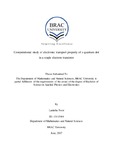Computational study of electronic transport property of a quantum dot in a single electron transistor
Abstract
Microscopic object’s conductance behaviours are totally different from those of the macroscopic ones and cannot be understood, let alone deciphered using classical approach. Nanoscale systems’ electron transport is not diffusive and has different carrier transport mechanism based on the contact type. Quantum dots are artificial atoms with the fascinating possibility of exploring their atomic states by applying current and voltage to them. They can be used to make single electron transistors where the quantum dot is kept separated from the source, drain and gate terminal by tunnel barriers. Quantum tunnelling causes current to flow when specific electrochemical potential requirements are met which can be achieved by varying the gate voltage. During this a phenomenon called Coulomb blockade is observed which is basically the appearance of oscillations in the conductance as a function of gate voltage. This is unique because it can only be observed for quantum dots and not in bulk materials. The conductance of the single electron transistor also varies with the temperature. All these characteristic behaviours can be deduced by carefully constructing and solving the rate equations. The acquired equations were then simulated using Python programs to plot the graphs for current versus voltage, differential conductance versus voltage, differential conductance versus temperature and maximum conductance versus temperature. The achieved graphs clearly depict how the current and the differential conductance are related to different source drain voltage at different gate voltages. The discrete conductance peak indicates different atomic states. Furthermore, it also outlines the fact that differential conductance depends on temperature and its value decreases as the temperature increases.

